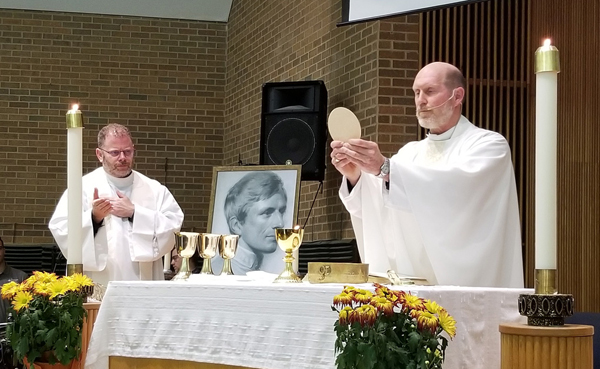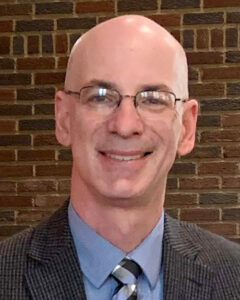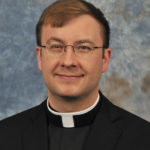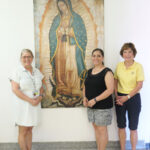
Bishop Thomas Zinkula, right, consecrates the Eucharist during Mass at Newman Catholic Student Center at the University of Iowa in Iowa City in this file photo as Father Jeffry Belger, priest director of the Newman Center, concelebrates.
By David Pitt
Eucharistic Revival
Eucharistic processions, such as the one beginning our three-year Eucharistic Renewal on June 19 (the Solemnity of the Most Holy Body and Blood of Christ), are occasions when faith meets enacted reality. What could be a clearer illustration of our desire to follow Christ in our lives than the act of joining with the local Church and following the real presence of Christ down city streets? It is an unambiguous symbol of our lifelong pilgrimage of faith toward the reign of God. It is equally representative of the Church’s description of the liturgy as being both “fount” and “summit” — that from which we are born and towards which we journey.
Processions clearly draw out that dimension of journeying from place to place. On Palm Sunday, the Church moves from a space outside the regular worship space into the church to sing Hosanna again. On Holy Thursday, we move from the tabernacle to a separate altar of repose to wait and pray. At the Easter Vigil, we move from the paschal fire into the main building with the light of Christ reflecting off our faces. At Mass, the Communion procession draws us from our place towards the altar to receive the body of Christ.

The foundation of our journey, the center of the Church’s liturgical life, is Sunday Mass, and the center of the Mass is the eucharistic prayer. For within the eucharistic prayer, we are being most clearly who God has called us to be! Here we join our voices together with angels, saints and the whole Church throughout time and space and offer praise to God through, with and in Jesus Christ, in the power of the Holy Spirit. Of course, we ask God to send the Spirit to transform our gifts of bread and wine into the presence of Christ, the very one who guides our journey. In technical terms, this calling down of the Holy Spirit is called the epiclesis.
Eucharistic prayers include a second epiclesis. We again ask the Holy Spirit to transform all those who eat and drink into the body and blood of Christ: “Grant that we, who are nourished by the Body and Blood of your Son and filled with his Holy Spirit, may become one body, one spirit in Christ.” Just as the ordinary elements of bread and wine are changed, so too are the people who consume them. Both the elements and the people become the body of Christ in a real way. As St. Augustine argued, “It is your own mystery that you are receiving! You are saying ‘Amen’ to what you are.”
Transubstantiation describes the way in which bread and wine are changed into the body and blood of Christ — literally, how the substance (the quality that makes a thing that thing) is changed. When the term was first used officially at the Fourth Lateran Council in 1215, transubstantiation could be understood in three different ways. First, addition. The substance of bread and wine remained in the Eucharist and the substance of Christ was added to it. Second, replacement. The substance of bread and wine disappeared and was replaced by the substance of Christ. Third — the option eventually preferred by the Catholic Church — transformation. The substance of bread and wine is transformed into the substance of Christ. This option is especially helpful when considering the second epiclesis. The Church asks the Spirit to transform those who share in eating and drinking the Eucharist into the body of Christ. Transformation. The presence of Christ is not simply added to us when we eat. The presence of Christ does not replace us when we drink. Rather, we say “Amen” to being transformed into the real presence of Christ. We can return here to the insistence of the Constitution on the Liturgy that the liturgy is simultaneously summit and fount. As we journey towards the Eucharist, we participate in a weekly and lifelong journey of transformation. As we process behind the Eucharist, another epiclesis ought to be taking place.
On Palm Sunday, those unchanged after singing “Hosanna” may well turn their cries to “Crucify him!” On Holy Thursday, those unchanged after eating and drinking at the Lord’s Supper may well fall asleep, flee, deny. At the Easter Vigil, those unchanged after following a pillar of fire through the waters may well wish themselves back in the relative comfort of slavery worshiping idols of their own making. At Communion, those unchanged after receiving our own mystery at the table may well fail to discern the real presence of Christ in those others around us — and perhaps even in ourselves.
(David Pitt, Ph.D., is associate professor of Theology at Loras College in Dubuque, Iowa.)











